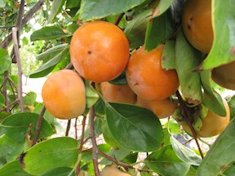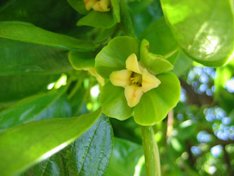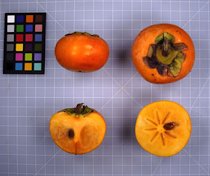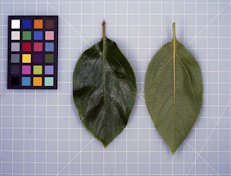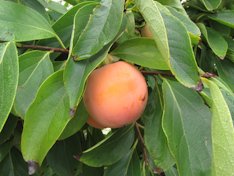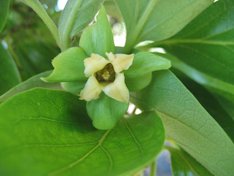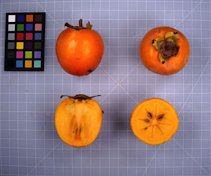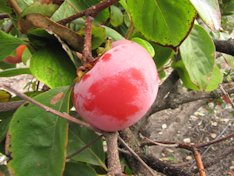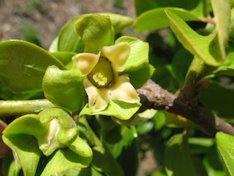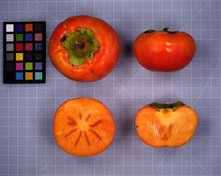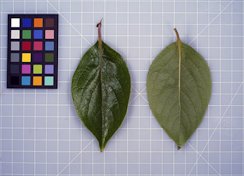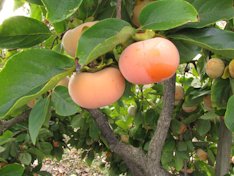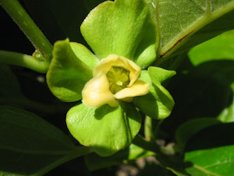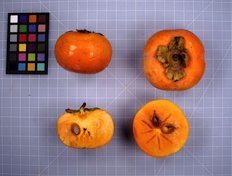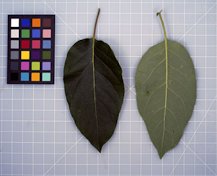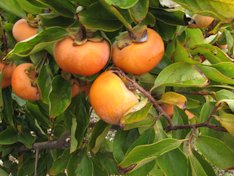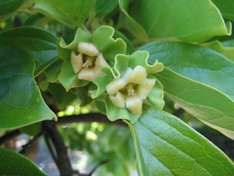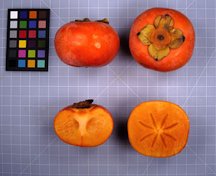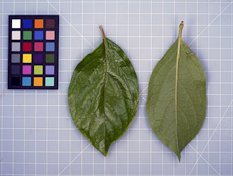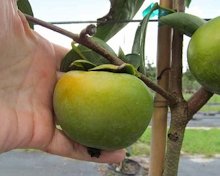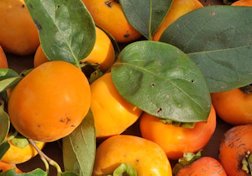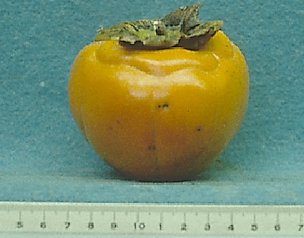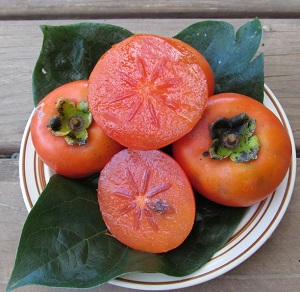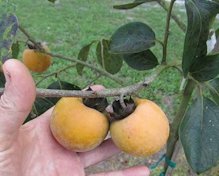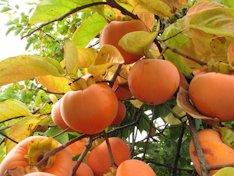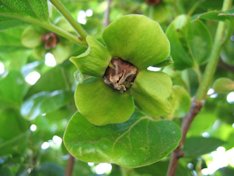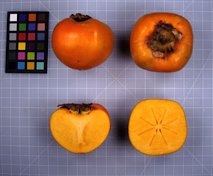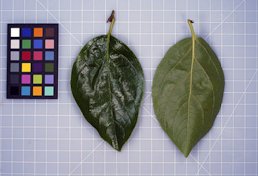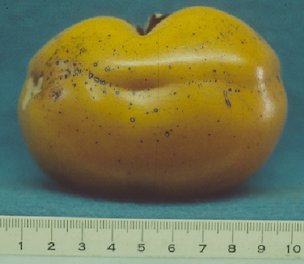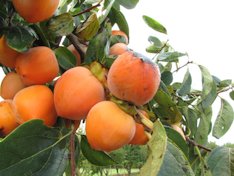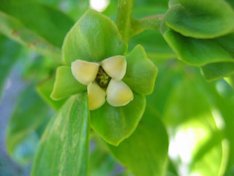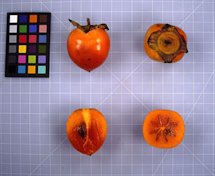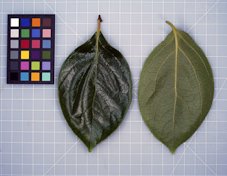Persimmon Varieties In great contrast to the native American persimmon, Diospyros virginiana L., which has never advanced beyond the status of a minor fruit, an oriental member of the family Ebenaceae, D. kaki L., is prominent in horticulture. Perhaps best-known in America as the Japanese, or Oriental, persimmon, it is also called kaki (in Spanish, caqui), Chinese plum or, when dried, Chinese fig. 1 Of the 2,000 cultivars known in China, cuttings of 52, from the provinces of Honan, Shensi and Shansi, were brought into the United States in 1914. J. Russell Smith, an esteemed economic-geographer, collected a number of types near the Great Wall of China in 1925 and some of the trees still survive in his derelict orchard in the Blue Ridge Mountains of southern Virginia. Over 800 kinds are grown in Japan but less than 100 are considered important. Among prominent cultivars are the non-astringent 'Fuyu', 'Jiro', 'Gosho' and 'Suruga'; the astringent 'Hiratanenashi', 'Hachiya', 'Aizumishirazu', 'Yotsumizo' and 'Yokono'. 1 The Persimmon cultivars are divided into two categories, namely "Astringent and Non-astringent" persimmons. Astringent: Astringent cultivars have a taste that puckers the mouth, numbs the tongue, and constricts the throat. This taste is caused by astringent substances such as tannins. The astringent taste is dominant in unripened bananas, unripe persimmons, and acorns, and it prevents them from being eaten (Figure 1). The compound which causes the astringent experience when eating persimmons has been found to be water-soluble tannin (kaki-tannin), which is located in tannin cells of the fruit. When these cells burst in the chewing process, the tannin adsorbs to the protein on the tongue and gives a sensation of dehydration. Astringent fruit must be soft or artificially treated to remove astringency and make them suitable for eating. 8 Non-astringent: Can be eaten even in it's hard, orange stage as the tannin content is greatly reduced, the moment it turn from green to orange. Non-astringent cultivars have lost their astringency by maturity and can be eaten crisp like an apple or at various stages of softness. 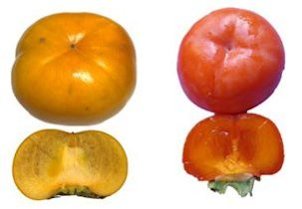 Fig. 1 Nonastringent persimmon 'Fuyu' (left) and astringent 'Hiratanenashi' (right) ready-to-eat cultivars Each group can be further classified on their response to pollination into: pollination constant (no change in flesh color after pollination) and pollination variant (flesh is light color when seedless and dark when seeded, especially around the seed). 9 Pollination variant varieties (astringent when seedless): includes those that are astringent when they have several seeds, and partially or totally non-astringent when they have only one or a few seeds. The flesh is yellow when there are no seeds and dark when seeds are present ('Rama Forte', 'Guiombo', 'Luiz de Queiroz', 'Hyakume', 'Chocolate', etc.). Pollination-constant types lack the dark streaking regardless of seed set. In astringent cultivars of the pollination-variant type, the dark flesh is nonastringent even when hard; therefore, seeded, pollination-variant astringent cultivars perform as nonastringent types. The amount of dark flesh coloration around the seeds varies with cultivars. In most areas of the world, astringent pollination-variant types, which have a great amount of dark flesh, are classified as nonastringent cultivars. However, typically in Florida, these persimmons are grown without pollinators, and their seedless astringent fruit necessitates classifying them as astringent types. Some dark specks can be found in the flesh of 'Fuyu' and other nonastringent cultivars. This is not linked to seed set and has no significance to the variant-constant classification system. 8 Plantings of non-astringent persimmons can be made to include cultivars that will ripen fruit from late September to early December. The cultivars recommended seem to produce the highest percent of marketable fruit. ‘Izu’ is the choice for the early season, ‘Matsumoto' Wase' for the mid-season, and ‘Fuyu’ for the late season. 'Fuyu' is the most readily available and is generally considered the best commercial non astringent cultivar in Florida. 3 'Chocolate' Astringent When Seedless - Late Season D. lotus 200 hrs Small to medium-sized, oblong-conical fruit. Skin reddish orange. Flesh brown-streaked when pollinated, must be soft-ripe before eating. Ripens late October to early November. Tree large, vigorous, producing many male blossoms. Recommended as a pollinator for pollination variant cultivars such as 'Hyakuma' and 'Zenji Maru'. 4 Choice of connoisseurs. Astringent type fruit develops sweet, spicy brown flesh when pollinized by another variety of Asian persimmon. Can be ripened off tree. The best pollinizer for the 'Nishimura Wase' is 'Coffee Cake' variety. Named chocolate because this medium-sized Japanese type persimmon has a chocolaty-brown flesh that is extremely tasty and sweet. Ripens late October into early November. Climate Zones: 7 to 11 'Eureka' Astringent - Mid Season D. kaki  Fig. 2 ‘Eureka’ has been widely propagated by southern nurseries and is a common cultivar in Texas. It has a large, round, flat-shaped, pollination variant fruit with a medium amount of dark flesh around the seed. 3,8 Puckered at the calyx. Skin bright orange-red. Good quality. Ripens late. Tree small, vigorous, drought and frost resistant, precocious and heavy-bearing. One of the most satisfactory cultivars for Florida and Texas. 4 Late (Nov. in Florida). 1 'Fuyu' Non-Astringent - Late Season D. kaki
The 'Fuyu', also known as 'Fuyugaki' ("winter persimmon"), is the most popular non-astringent tree in Florida and is the most widely grown persimmon cultivar in the world. This large, round, flattened fruit has reddish-orange skin when ripe. It is weakly 4-sided and, with very few seeds. The tree bears at a young age and is a heavy producer. Self fertile and pest free. The fruit is seedless and is excellent for fresh eating or cooking. Fruit thinning is usually necessary to ensure large fruit, prevent clustering and regulate crop loads. Incidence of fruit imperfections are low, yields are good, and the tree is generally well adapted. Soluble solids average 18 to 19%. Many different cultivars with the name ‘Fuyu’ or ‘Fuyugaki’ exist. The best cultivar is the one commonly available in Florida. Harvest season is mid-November through early December. 'Fuyu' is highly recommended for north and north central Florida. 3,8 Pollination constant. From Fruit Varieties & Horticultural Digest, Vol. 21(1), 1970, p. 6: Medium-to-small size, oblate shaped fruit with attractive orange-red skin and non-astringent flesh. The flesh is deep orange and contains many small specks. 'Fuyu' is noted for its complete lack of astringency, even when firm. From Persimmons for California, by Kay Ryugo, et al, California Agriculture, July-August 1988, p. 9: The leaf isozyme patterns and fruit size and eating quality indicate that this cultivar is identical to the original cultivar 'Fuyu', widely grown in Japan. Trees tend to bear in alternate years, producing large quantities of small fruit in the "on" year and a modest crop of large fruit in the "off" year. In Japan, the crop is thinned early in the on year to obtain large fuit at harvest. 2 The most popular non-astringent variety, but hardy to only 15° F. 7 'Gailey' Astringent - Mid Season D. kaki ‘Gailey’ is the standard pollinating cultivar and has small to medium size fruit. Concentric ring cracking is common and its pollination variant fruit are very dark-fleshed, even with small seed numbers. 3 Fruit roundish to conical with a rounded apex. Skin dull red, pebbled. Flesh dark, firm, juicy, of fair flavor. Tree small to medium. Bears many male flowers regularly and is an excellent cultivar to plant for cross-pollination. Has attractive autumn foliage and ornamental value. 4 ‘Giombo' Astringent - Early Season D. kaki 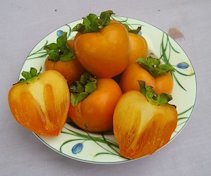 Fig. 7  ‘Giombo’ is similar to ‘Saijo’ in fruit quality, although the fruit are much larger and begin ripening 2 weeks later. Fruit are light translucent orange and thin-peeled with a sweet, juicy, jelly type flesh. ‘Giombo' fruit are a connoisseur’s choice. The tree is early to start growth in the spring and is sometimes injured by freezing temperatures. 3,8 'Giombo' (perhaps the same as 'Korean') is one of the best in Florida, with thin skin; but it is a biennial bearer when young. 1 'Great Wall' Astringent - Mid Season D. kaki 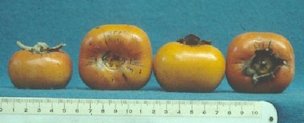 Fig. 8 ‘Great Wall’ is a strong growing, upright tree having small 4-sided fruit. The flesh is dry, similar to ‘Tanenashi’, but of excellent quality. 3,8 'Great Wall' is small, flat, with fine black stripes extending from the calyx; astringent, a biennial bearer; does well in Florida. 1 Hardy to 0° F. 7 'Hachiya' Astringent - Mid Season D. kaki 200 hrs 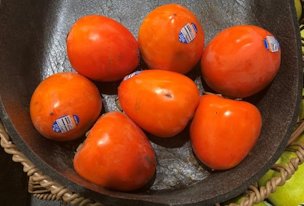 Fig. 9  The Japanese 'Hachiya' persimmon tree is remarkably cold tolerant and vigorous in the South when grafted on native American persimmon. The Japanese 'Hachiya' produces delicious persimmon fruit that keeps very well when refrigerated. The 'Hachiya' often bears so much persimmon fruit that the limbs have to be propped up with bamboo poles. The 'Hachiya' has been dried in Japan for markets of delicious dried persimmon fruit. The variety most often found in stores. The 4" long acorn shaped fruit is deep orange when ripe and very sweet and flavorful. Astringent until ripened off the tree and eaten when soft. Doesn't need a pollinizer. Oblong-conical, 3 3/4 in (9.5 cm) long, 3 1/4 in (8.25 cm) wide; skin glossy, deep orange-red; flesh dark-yellow with occasional black streaks. Seedless or with a few seeds. Mid season to late. Tree well-formed and prolific in Kulu Valley, India. 1 ‘Hachiya’ is a commercial cultivar in California. Ability to set and hold fruit is sometimes a problem if this cultivar is propagated onto Diospyros virginiana rootstock. The fruit are high quality and jelly-fleshed with an attractive red skin coloration. Fruit will often have concentric ring cracking at the apical end and will ripen unevenly starting from these points. In Japan, 'Hachiya' is mostly used for drying. 3,8 Climate Zones: 7 to 10 'Hanagosho' Non Astringent - Mid Season D. kaki 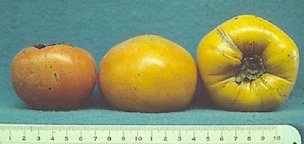 Fig. 10 ‘Hanagosho’ ("flower of the Imperial Palace") is a large tree with vigorous upright growth and a strong scaffold system. The tree will usually have a small amount of male flowering every year and crop regulation is good. The fruit and leaves are slightly more susceptible to late season pathogens than most cultivars. ‘Hanagosho’ is a large tree and a good homeowner cultivar. 3,8 ‘Hanagosho’ is of excellent quality but in Florida is slow in losing astringency and the tree is deficient in male flowers. 'Hana Fuyu' Non Astringent - Mid Season D. kaki 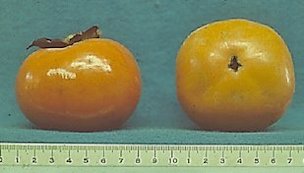 Fig. 11 ‘Hana Fuyu’, also known as ‘Yotsundani’, or ‘Giant Fuyu’, regulates crop loads well and is of medium vigor. The fruit are slightly larger than most, generally free of imperfections and may be slow to lose astringency. The tree is a good homeowner cultivar. 3,8 It is self fruitful and the fruit tastes sweet with a fine flavor, even in the green stage! It is easy to grow either in hot, dry or cold climates. It also grows about twice the size of the regular 'Fuyu' persimmon. The skin reveals a bright red pulp that is delicious and aromatic. The fruit is crunchy when ripe and is non-astringent. ‘Hana Fuyu’ is oblate, and usually seedless; late mid season; tree is small, bears regularly but yield is low; prone to premature shedding of fruit; fairly common in northern Florida. 1 'Hiratanenashi' Astringent - Mid Season D. kaki
‘Hiratanenashi’ is a widely grown commercial cultivar in Japan. The fruit have a thick peel and a long shelf life. The flesh is juicy, somewhat watery and almost always seedless. The astringency is sometimes difficult to remove after the fruit have been harvested unless they are artificially treated. 3,8 'Ichi Ki Kei Jiro' Non Astringent - Mid Season D. kaki
‘Ichikikei Jiro’ is a bud sport from 'Jiro'. The tree is comparatively smaller than most and regulates its crop loads well. It will mature seedless crops and is a good homeowner cultivar. Apical end splitting usually occurs in a percentage of the fruit. The tree is around 7 days later than most cultivars to begin growing in the spring. This sometimes helps it to escape spring freeze injury. Harvest season is mid-October to mid-November. 'Ichikikei Jiro' is recommended for north and north central Florida. 3,8 'Ichikikei Jiro' is medium-large, oblate, orange, non-astringent; early-ripening; tree is not vigorous but still this cultivar is among the best of the non-astringent class in Florida. 1 Recommended for the Gulf Coast. Hardy to 0° F. 7 'Izu' Izu is a seedling of Fuyu x Okugosho. Non-Astringent - Early Season D. kaki 100 hrs
The earliest ripening of the good quality Asian persimmons, about three weeks before 'Fuyu'. This is a non-astringent selection. It sets medium sized fruit on a dwarf tree. Very sweet, tasty, medium to large size, round shape. Relatively small tree, good choice for backyard persimmon. Sometimes difficult to start from bareroot. 100 hours. This is the best variety in areas where ripening is a problem. Self fertile. 'Izu' has the distinction of being the earliest ripening nonastringent cultivar. Tree vigor is very low, and it is not precocious. Fruit size is medium-large, and soluble solids average 16%. Fruit shape is oblate, and a fair percentage of fruit show imperfections. Harvest season is late September through mid-November. 'Izu' is sometimes recommended due to early ripening. 8 'Jiro' Non-Astringent - Mid Season D. kaki 200 hrs
Pollination constant. From Persimmons for California, by Kay Ryugo, et al, California Agriculture, July-August 1988, p. 9: This cultivar has also been propagated and sold as 'Fuyu' in California. 'Jiro' fruits are more truncated and squarish in cross-section than those of 'Fuyu'. Leaves of 'Jiro' trees, more so than 'Fuyu' leaves, appear chlorotic in the early spring, especially after a cold, wet winter. 'Jiro' is moderate in tree vigor. Cropping can be erratic when trees are young, but more consistent yield is produced on older trees. Fruit size is medium-large, soluble solids are 16%–19%, and fruit shape is oblate. Some tip cracking on fruit may occur. Harvest season is mid-October through mid-November. 'Jiro' is recommended. 8 Hardy to 0° F. 7 'Maekawa Jiro' Non-Astringent D. kaki 200 hrs
Round and flat with an orange skin and sweet mild flesh. It is a non-astringent type, great eaten while firm. Firm and crunchy with a sweet sugar cane like flavor. Doesn't need a pollinizer. Needs a long hot summer to ripen reliably. A popular dooryard fruit and a handsome ornamental with drooping leaves and branches that give it a languid, rather tropical appearance. Under mild autumn conditions the leaves often turn dramatic shades of yellow, orange and red. Tea can also be made from fresh or dried leaves. 'Maekawa Jiro', a bud sport of Jiro, is low to moderate in vigor. Fruit size is large, and fruit shape is oblate. There is some tendency for fruit to incur tip cracking. Harvest season is mid-October to mid-November. 'Makawa Jiro' is not recommended for north and north central Florida. 8 Climate Zones: 7 to 11 'Matsumoto Wase Fuyu' Non Astringent - Mid Season D. kaki 200 hrs
‘Matsumoto Wase Fuyu’ is an earlier ripening bud sport of ‘Fuyu’ discovered by Mr. Matsumoto. The tree sets many flowers and produces heavy clustered crops. The clusters should be thinned to prevent bent limbs with excessive fruit loads. Larger fruit are sometimes prone to calyx separation. The tree is moderately vigorous and of medium size. Soluble solids range from 16% to 19%, which is generally true for most mid-season types. Fruit is medium in size and oblate in shape. There is little or no tendency for fruit to incur tip cracking. 3,8 One of our favorites. Firm and crunchy with a sweet sugar cane like flavor. Known for it’s early ripening, this is a good variety for short season areas. 'Masumoto' persimmon tree is a small grower, rarely exceeding 15 foot in height. Fruit ripens mid-October through mid-November. Climate Zones 7-9. 6 'Midia' Non Astringent - Mid Season D. kaki
'Midia' trees are moderate in vigor but are more susceptible to tree decline than most other Japanese persimmons. Fruit set and fruit retention until harvest are not consistently high. 'Midia' produces the largest fruit of any cultivar of nonastringent persimmon. Fruit shape is round with an indented ring around the top of the fruit. Harvest season is late October to mid-November. 'Midia' is not recommended for north and north central Florida. 8 'Nikita's Gift' Astringent D. virginiana x D. kaki
The fruit from the 'Nikita's Gift' hybrid persimmon tree is astringent until it is fully ripe much like one of the parents, the American persimmon, Diospyrous virginiana; and the ripe stage color is orange-red and very sweet, a genetic inheritance from the Oriental persimmon parentage Diospyrous kaki. The ripened fruit can be 3 inches long with a rather flattened shape that is attached to the twigs on the trees in large clusters when first formed, but thinning the fruit on the branches will increase the fruit's size. Most outstanding persimmon trees that were growing in the past have been limited to the Southern U.S., but now 'Nikita's Gift' from Yalta in the Ukraine has released this Russian hybrid persimmon that blends the color and flavor of the oriental persimmons D. kaki with the cold hardiness and late ripening characteristics of the American persimmon to produce this hybrid that was licensed for growing in the U.S. by the Ukraine, formerly a Russian republic. 'Nishimura Wase' Astringent When Seedless - Early Season D. kaki 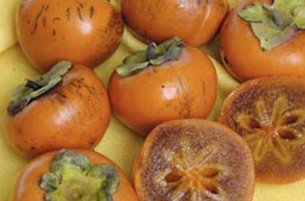 Fig. 34 ‘Nishumura Wase’ is an early cultivar, ripening its first fruit in early August. It is pollination variant and must be fully seeded to be non-astringent. It consistently sets male flowers. The fruit have soluble solids around 13% to 15% and are somewhat watery. The tree is well-spreading, somewhat vigorous and a good annual cropper. 3,8 The fruit is large and roundish. The tree is vigorous and easy to grow. It is called Coffee Cake for its rich flavor and brown flesh color when ripe. Unique spicy-sweet flavor that instantly evokes images of cinnamon pastry, hot coffee and morning sunshine. Coffeecake™ ripens about the same time as Chocolate and about three weeks to one month earlier than 'Fuyu'. It is a non astringent pollination variant which means it develops its rich sweet flavor best when it is pollinized. 'Gosho' and 'Chocolate' are the best pollinizers. Climate Zones: 7 to 10 'Ormond' Astringent - Late Season D. kaki 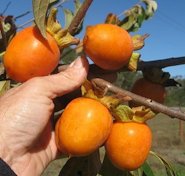 Fig. 35  ‘Ormond’ is sometimes called the Christmas persimmon. Fruit are long, conic and are often harvested in January. The tree begins growing early in the spring which increases chances for freeze injury. 3,8 'Ormond'–oblong-conical, 2 5/8 in (6.5 cm) long, 1 7/8 in (4.7 cm) thick. Skin reddish-yellow with thin bloom; flesh orange-red, moderately juicy; seeds large. Very late. Keeps well. 1 Often the last tree to finish ripening it’s fruit. The 'Ormond' persimmon tree is a vigorous mid size growing tree. with beautiful small sized long, fruits that hang in heavy clusters like grapes. We harvest and serve them as in clusters for bite size snacks. Fabulous variety for central Florida. Fruit ripens December to January. Climate Zones 8-9. 6 'Saijo' Astringent - Early Season D. kaki 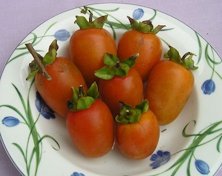 Fig. 36  ‘Saijo’ ("the very best one") is considered one of the sweetest persimmons although traces of astringency sometimes remain when the fruit is soft. Fruit ripen early to mid-season and are relatively small with a long conic shape, and a translucent orange jelly type flesh. Soluble solids range from 16 to 22%. The large, upright, vigorous tree is capable of producing heavy yields. It is a good homeowner type. 3,8 'Saijo' fruits are like small orange plum shapes balls of honey. Free of seeds and a consistent bearer. The 'Saijo' persimmon tree is a large, upright grower, makes a good small shade tree. One of the first persimmon fruits of the season, starting in September, and continuing into October. Climate Zones 7-9. 6 Skin resists cracking. Dries and stores well. 7 'Sheng' Astringent - Mid Season D. kaki 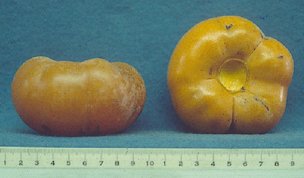 Fig. 37  ‘Sheng’ is a well spreading tree with large fruit having six lobed sections looking somewhat like a 4 or 6 leaf clover from the top. Fruit have a high jelly content, are bright orange, and when pollinated will set many seed. 3,8 The most beautiful persimmon of all! Shaped just like a miniature pumpkin. The fruit is flat, and is ribbed and tucked in around the calyx. Flavor is spicy sweet. The 'Sheng' persimmon tree is a medium sized tree, bearing good crops consistently. The tree has some cold tolerance. Fruit ripens mid September through mid October. Climate Zones 6-9. 6 Trees are similar to 'Hana-Gosho' but more dwarf. 7 'Shogatsu' Non-Astringent - Mid Season D. kaki 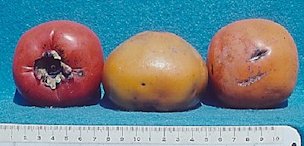 Fig. 38 ‘Shogatsu’ is similar to ‘Hanogosho’ in tree habit, however, more problems with fruit end splitting and leaf spots occur. 3,8 'Shogatsu' is flattened, non-astringent, of fair quality; bears an abundance of male flowers. Does well in Florida. 1 'Suruga' Seedling of Hanagosho x Okugosho Non-Astringent - Late Season D. kaki 200 hrs
'Suruga' (distributed in 1959); orange-red, non-astringent, very sweet, keeps well. 'Suruga' is the sweetest of the non-astringent types with soluble solids often 18- 21%. Red coloration in mature fruit is strong, and fruit imperfections are fairly common. Seeded crop loads must be thinned to prevent over production. Harvest season is late November to early December. It appears to be susceptible to premature defoliation. 'Suruga' is not recommended for commercial cultivation. 3,8 Recommended for the Gulf Coast. 1,7 'Tamopan' Astringent - Late Season D. kaki 200 hrs
Introduced from China in 1905, again in 1916 (S.P.I. Nos. 16912, 16921, 26773). Broad oblate, somewhat 4-sided; indented around the middle or closer to the base; 3 to 5 in (7.5-12.5 cm) wide; skin thick, orange-red; flesh light-orange, usually astringent until fully ripe, then sweet and rich. In some parts of China and Japan said to be non-astringent. Seedless or nearly so. Of medium quality; late (Nov.) in Florida; midseason in California. Was being grown commercially in North Carolina and at Glen St. Mary, Florida, in 1916. 1 ‘Tamopan’ is a cultivar with large fruit that is juicy, watery and stringy, with a thick peel. More than one cultivar of this tree exists, some of which have better fruit than the one described. 3,8 'Tanenashi' Astringent - Mid Season D. kaki 200 hrs  Fig. 44  'Tanenashi' or 'Tananashi', which means seedless (seed in Japanese=tane). Oval, 4-5”, skin light yellow or orange, inside dark orange-red, eaten soft (=astringent), very sweet, seedless, vigorous tree, prolific. Leading cultivar in SE USA. 5 The 'Tanenashi' Persimmon produces all male flowers, so that the sweet delicious fruit when ripe is seedless. The astringent character of the 'Tanenashi' Persimmon can be avoided if the fruit is fully ripe and soft after picking from the tree. The Southeastern U.S. was planted into huge acreages of Japanese 'Tanenashi' Persimmon Trees, where the trees will produce fruit reliably every year, but in California the 'Tanenashi' cultivar tends to bear in alternate years. 1 Productive throughout Florida. ‘Tanenashi’, the most popular astringent cultivar in Florida, matures heavy crops without pollination and will seldom set seed even if pollinated. It is usually desirable to thin the fruit to obtain some vegetative growth during the year. The fruit, often large, 3½" across, can weigh over ¾ of a pound. Skin color is deep yellow to orange when mature. flesh is orange, pasty, comparatively dry, and of acceptable quality. Soluble solids average 16%. Harvest duration may extend from September through November. It is a good tree for homeowners. 3,8 Fruits are similar to 'Hachiya' but very slow to lose astringency. Popular in Japan. Thick skin, tends to be seedless. 7 'Thriumph' Astringent D. virginiana Native American Persimmon. Smaller, 2-3" fruit, astringent, doesn't need cold to bloom, eaten soft. A plum-like berry that is green before ripening, turning orange to black when ripe, 3/4 to 2 inches in diameter. Cold hardy. 'Triumph' oblate, faintly 4-sided; of small to medium size; skin yellowish to dark orange-red. Flesh yellowish-red, translucent, soft, juicy; seedless or with 5 to 8 seeds; astringent until fully ripe, then sweet. Of high quality. Medium-late. In Florida begins in September and lasts until mid-November. Productive throughout the state including South Florida. 1 'Yotsumizo' Astringent D. kaki
'Yokono' Astringent D. kaki 'Yokono' is large, orange-red, astringent, of good quality; bears well but tends to shed fruit; keeps well. 1 'Yomato Hyakume' Astringent - Mid Season D. kaki 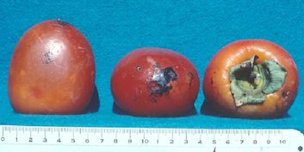 Fig. 49 ‘Yomato Hyakume’ is a pollination variant type, but will not have a great deal of dark flesh around the seeds. The fruit are large with a deep orange-red color. Concentric ring cracking often occurs. This cultivar is a heavy annual cropper with good fall leaf retention. It is excellent for dried fruit and is one of the best astringent types. 3,8 Back to Japanese Persimmon Page |
||||||||||||||||||||||||||||||||||||||||||||||||||||||||||||||||||||||
| Bibliography 1 Fruits of Warm Climates. Julia F. Morton, Miami, 1987. 2 "Diospyros kaki." USDA Agricultural Research Service, U.S. National Plant Germplasm System, GRIN-Global, ars-grin.gov. Accessed 18 Nov. 2014. 3 Miller, E. P., and T. E. Crocker. "Oriental Persimmon in Florida." Environmental Horticulture Dept., UF/IFAS Extension, SP 101, Original Pub. Apr. 1994, AskIFAS, edis.ifas.ufl.edu. Archived. Accessed 19 Nov. 2014. 4 "Persimmon." California Rare Fruit Growers, crfg.org. 1996. Accessed 20 Nov. 2014. 5 "Diospyros kaki." Top Tropicals, toptropicals.com. Accessed 20 Nov. 2014. 6 "Persimmon." Just Fruit and Exotics, justfruitsandexotics.com. Accessed 13 Mar. 2015. 7 Nardozzi, Charlie. "Persimmons." The National Gardening Association, Learning Library, garden.org/learn/articles/view/291/. Accessed 8 Nov. 2018. 8 Sarkhosh, Ali, et al. "Japanese Persimmon Cultivars in Florida." Environmental Horticulture Dept., UF/IFAS Extension, SP101, Original pub. Apr. 1994, Revised Feb. 2020, AskIFAS, doi.org/10.32473/edis-mg242-2020, edis.ifas.ufl.edu/ publication/mg242. Accessed 27 Feb. 2021. 9 Henty, Ted, Lae. "The Oriental Persimmon." Archives of the Rare Fruit Council of Australia, RFCI Tampa Chapter, Jan. 1988, July 1988, rfcarchives.org.au. Accessed 4 Oct. 2014. Photographs Fig. 1 Sarkhosh, Ali. "Nonastringent persimmon 'Fuyu' (left) and astringent 'Hiratanenashi' (right) ready-to-eat cultivars." Japanese Persimmon Cultivars in Florida, Environmental Horticulture Dept., UF/IFAS Extension, SP101, Original pub. Apr. 1994, Revised Feb. 2020, AskIFAS, doi.org/10.32473/edis-mg242-2020, edis.ifas.ufl.edu/ publication/mg242. Accessed 24 May 2021. Fig. 2 "'Eureka' cultivar." Japanese Persimmon Cultivars in Florida, Environmental Horticulture Dept., UF/IFAS Extension, SP101, Original pub. Apr. 1994, Revised Feb. 2020, AskIFAS, doi.org/10.32473/edis-mg242-2020, edis.ifas.ufl.edu/ publication/mg242. Accessed 24 May 2021. Fig. 3,4,5,6,13,14,15,16,17,18,19,20,21,22,23,24,25,26,27,28,39,40,41,42,45,46,47,48 Smith, J. "Diospyros kaki." USDA Agricultural Research Service, U.S. National Plant Germplasm System, GRIN-Global, ars-grin.gov. Accessed 18 Nov. 2014. Fig. 7,29,32,33,35,36 "'Giombo', 'Masumoto Wase Fuyu', 'Nikita's Gift', 'Ormond', ‘Saijo’." Just Fruit and Exotics, justfruitsandexotics.com. Accessed 13 Mar. 2015. Fig. 8 "'Great Wall' cultivar." Japanese Persimmon Cultivars in Florida, Environmental Horticulture Dept., UF/IFAS Extension, SP101, Original pub. Apr. 1994, Revised Feb. 2020, AskIFAS, doi.org/10.32473/edis-mg242-2020, edis.ifas.ufl.edu/ publication/mg242. Accessed 27 Feb. 2021. Fig. 9 Sarkhosh, Ali. "'Hachiya' cultivar." Japanese Persimmon Cultivars in Florida, Environmental Horticulture Dept., UF/IFAS Extension, SP101, Original pub. Apr. 1994, Revised Feb. 2020, AskIFAS, doi.org/10.32473/edis-mg242-2020, edis.ifas.ufl.edu/ publication/mg242. Accessed 27 Feb. 2021. Fig. 10 "'Hanagosho' cultivar." Japanese Persimmon Cultivars in Florida, Environmental Horticulture Dept., UF/IFAS Extension, SP101, Original pub. Apr. 1994, Revised Feb. 2020, AskIFAS, doi.org/10.32473/edis-mg242-2020, edis.ifas.ufl.edu/ publication/mg242. Accessed 24 May 2021. Fig. 11 "'Hana Fuyu' cultivar." Japanese Persimmon Cultivars in Florida, Environmental Horticulture Dept., UF/IFAS Extension, SP101, Original pub. Apr. 1994, Revised Feb. 2020, AskIFAS, doi.org/10.32473/edis-mg242-2020, edis.ifas.ufl.edu/ publication/mg242. Accessed 24 May 2021. Fig. 12 "'Hiratanenashi' cultivar." Japanese Persimmon Cultivars in Florida, Environmental Horticulture Dept., UF/IFAS Extension, SP101, Original pub. Apr. 1994, Revised Feb. 2020, AskIFAS, doi.org/10.32473/edis-mg242-2020, edis.ifas.ufl.edu/ publication/mg242. Accessed 27 Feb. 2021. Fig. 30 "'Masumoto Wase Fuyu' cultivar." Edible Landscaping, Japanese Persimmon Cultivars in Florida, Environmental Horticulture Dept., UF/IFAS Extension, SP101, Original pub. Apr. 1994, Revised Feb. 2020, AskIFAS, doi.org/10.32473/edis-mg242-2020, edis.ifas.ufl.edu/ publication/mg242. Accessed 24 May 2021. Fig. 31 "'Midia' cultivar." Sperling Nursery and Gift Shop, Japanese Persimmon Cultivars in Florida, Environmental Horticulture Dept., UF/IFAS Extension, SP101, Original pub. Apr. 1994, Revised Feb. 2020, AskIFAS, doi.org/10.32473/edis-mg242-2020, edis.ifas.ufl.edu/ publication/mg242. Accessed 24 May 2021. Fig. 34 "'Nishumura Wase' cultivar." Sperling Nursery and Gift Shop, Japanese Persimmon Cultivars in Florida, Environmental Horticulture Dept., UF/IFAS Extension, SP101, Original pub. Apr. 1994, Revised Feb. 2020, AskIFAS, doi.org/10.32473/edis-mg242-2020, edis.ifas.ufl.edu/ publication/mg242. Accessed 24 May 2021. Fig. 37 "'Sheng' cultivar." Japanese Persimmon Cultivars in Florida, Environmental Horticulture Dept., UF/IFAS Extension, SP101, Original pub. Apr. 1994, Revised Feb. 2020, AskIFAS, doi.org/10.32473/edis-mg242-2020, edis.ifas.ufl.edu/ publication/mg242. Accessed 24 May 2021. Fig. 38 "'Shogatsu' cultivar." Japanese Persimmon Cultivars in Florida, Environmental Horticulture Dept., UF/IFAS Extension, SP101, Original pub. Apr. 1994, Revised Feb. 2020, AskIFAS, doi.org/10.32473/edis-mg242-2020, edis.ifas.ufl.edu/ publication/mg242. Accessed 24 May 2021. Fig. 43 "'Tamopan' cultivar." Japanese Persimmon Cultivars in Florida, Environmental Horticulture Dept., UF/IFAS Extension, SP101, Original pub. Apr. 1994, Revised Feb. 2020, AskIFAS, doi.org/10.32473/edis-mg242-2020, edis.ifas.ufl.edu/ publication/mg242. Accessed 27 Feb. 2021. Fig. 44 "'Tanenashi' cultivar." Japanese Persimmon Cultivars in Florida, Environmental Horticulture Dept., UF/IFAS Extension, SP101, Original pub. Apr. 1994, Revised Feb. 2020, AskIFAS, doi.org/10.32473/edis-mg242-2020, edis.ifas.ufl.edu/ publication/mg242. Accessed 27 Feb. 2021. Fig. 49 "'Yomato Hyakume' cultivar." Japanese Persimmon Cultivars in Florida, Environmental Horticulture Dept., UF/IFAS Extension, SP101, Original pub. Apr. 1994, Revised Feb. 2020, AskIFAS, doi.org/10.32473/edis-mg242-2020, edis.ifas.ufl.edu/ publication/mg242. Accessed 24 May 2021. Published 18 Nov. 2014 LR. Last update 25 Nov. 2021 LR |
||||||||||||||||||||||||||||||||||||||||||||||||||||||||||||||||||||||
